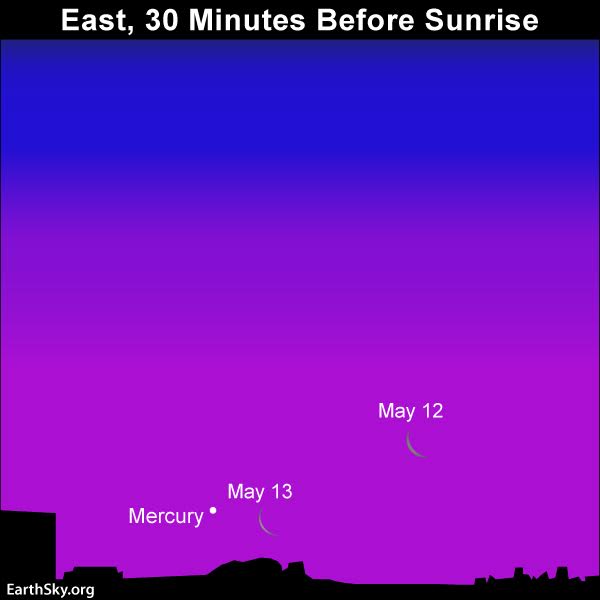People in the Southern Hemisphere have the big advantage for catching the crescent moon and the planet Mercury in the eastern sky before sunrise on May 12 and 13, 2018. In fact, our featured chart at top is for Cape Town, South Africa (roughly the same latitude as Sydney, Australia; Auckland, New Zealand; Santiago, Chile). Given an unobstructed horizon and clear sky, the old waning crescent moon and planet Mercury will be easy to spot in the Southern Hemisphere (and the northern tropics) with the eye alone.
For the Southern Hemisphere, this morning apparition of Mercury is the best of 2018.
For us at mid-northern latitudes (U.S., Canada, Europe and Asia), the moon and Mercury will be much, much harder to spot in the glow of morning dawn. For us in the Northern Hemisphere, this is the poorest morning apparition of Mercury for the year. At mid-northern latitudes, Mercury rises less than one hour before the sun. The chart below well illustrates our dim prospects at northerly latitudes.

Here’s the Northern Hemisphere view on May 12 and 13, 2018. The moon and Mercury will be much harder to catch at northerly latitudes.
As seen from the entire Earth, we’re nearing the end of Mercury’s showing in the morning sky. No matter where you live worldwide, it’s to your advantage to find an unobstructed horizon in the direction of sunrise for any Mercury quest. Before sunrise on May 12, the lighted portion of the waning crescent moon will be pointing toward Mercury. On May 13, the moon will be closer to Mercury.
Just remember … binoculars come in handy for any Mercury search.
Bottom line: On May 12 and 13, 2018, look for the waning crescent moon and Mercury, the innermost planet of the solar system, in the eastern sky before sunrise.
from EarthSky https://ift.tt/2IwanKg
People in the Southern Hemisphere have the big advantage for catching the crescent moon and the planet Mercury in the eastern sky before sunrise on May 12 and 13, 2018. In fact, our featured chart at top is for Cape Town, South Africa (roughly the same latitude as Sydney, Australia; Auckland, New Zealand; Santiago, Chile). Given an unobstructed horizon and clear sky, the old waning crescent moon and planet Mercury will be easy to spot in the Southern Hemisphere (and the northern tropics) with the eye alone.
For the Southern Hemisphere, this morning apparition of Mercury is the best of 2018.
For us at mid-northern latitudes (U.S., Canada, Europe and Asia), the moon and Mercury will be much, much harder to spot in the glow of morning dawn. For us in the Northern Hemisphere, this is the poorest morning apparition of Mercury for the year. At mid-northern latitudes, Mercury rises less than one hour before the sun. The chart below well illustrates our dim prospects at northerly latitudes.

Here’s the Northern Hemisphere view on May 12 and 13, 2018. The moon and Mercury will be much harder to catch at northerly latitudes.
As seen from the entire Earth, we’re nearing the end of Mercury’s showing in the morning sky. No matter where you live worldwide, it’s to your advantage to find an unobstructed horizon in the direction of sunrise for any Mercury quest. Before sunrise on May 12, the lighted portion of the waning crescent moon will be pointing toward Mercury. On May 13, the moon will be closer to Mercury.
Just remember … binoculars come in handy for any Mercury search.
Bottom line: On May 12 and 13, 2018, look for the waning crescent moon and Mercury, the innermost planet of the solar system, in the eastern sky before sunrise.
from EarthSky https://ift.tt/2IwanKg

Aucun commentaire:
Enregistrer un commentaire